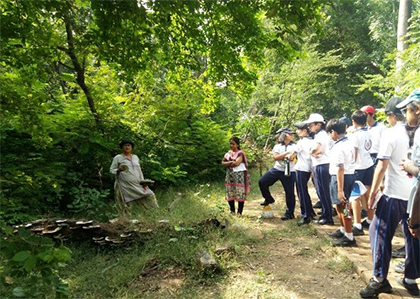CLASS TRIP - 6
Trip to Maharashtra Nature Park
Class 6 visited the Maharashtra Nature Park on 13th November, 2017. The Maharashtra Nature Park in Sion, Mumbai, is a mini forest that was created on an erstwhile dumping ground.
Students of 6 B at the Park

Students of 6A in a perfect frame of natural sculptures

What we learned and observed:
Bracket Fungus

Our guides told us that this entire area of 37 acres is known to house over 13,000 trees of 300 different varieties. Plants like the Teak, Bottle Brush Oak, Golden Apple, Flame of the Forest, and the Devil’s tree can be spotted here. In addition, over 500 different species of plants thrive here.
An interesting fact is that the juice of the leaves of the Papaya plant, could be used to cure dengue. Other unique plants which we saw were the Red Silk Cotton Tree and the ‘Touch Me Not’ which closed its leaves whenever anyone touched it. Unusual growth of parasites like the bracket fungus can be observed on fallen trucks of trees.
The park boasts of 50 species of snakes, of which some are nocturnal. The cobra is quite a common sight at this park. Also seen are the Russell’s viper and the Green Vine snake. There are over 40 different species of butterflies like the Indian Rock Bee, damselflies, the Coromandel Marsh Dart, the Pumpkin beetle and many more at the park. The Blue Tiger Butterfly came flitting to the tantalizing magenta flowers and we clicked a perfect picture of this wondrous sight.
The Blue Tiger Butterfly

We learnt that this park is home to many different birds like the Shikara, Black kite, Eurasian Wryneck, Great Egret, Purple Sunbird and the Little Green Bee Eater. Some of these are migratory birds that people come here to watch from close quarters. An amazing 125 species of birds can be spotted here from time to time.
Rain Water Harvesting Pond

The park has its own rain water harvesting pond that takes care of their water requirements. From the park one could see the Mithi River. This was a distressing sight as it has become a dump. People are using this river to throw garbage and it is also used as an open toilet.
This trip had a profound impact on all of us, as it taught us the importance of nature and how we must respect it. The visit was also memorable because it taught us about the biodiversity in nature.
We think that we should have more national parks around India so we can save the flora and fauna that abounds in India and also have parks where people can go and observe nature in its full glory.
Students of 6 A & B

